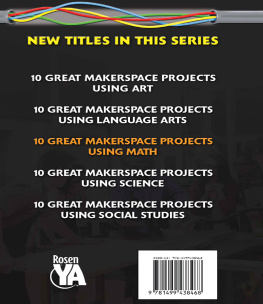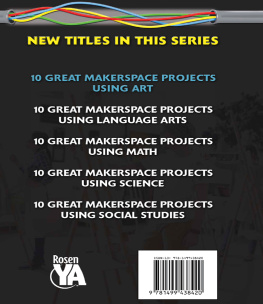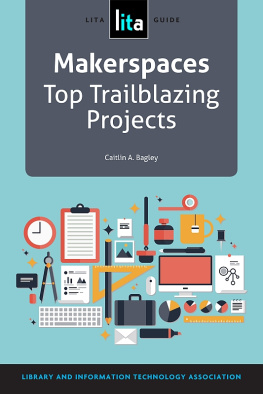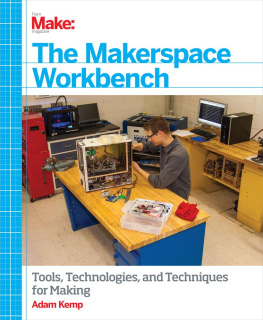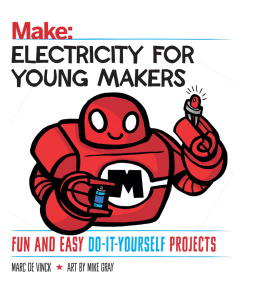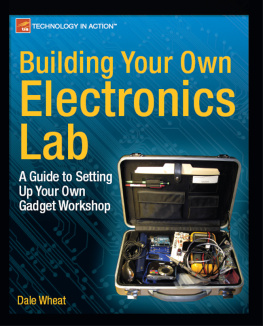The Makerspace Workbench
Adam Kemp
Dedication
For my boys and to making things together.
Preface
Welcome to the world of tomorrow! What started off in the basements of hardware hackers and the minds of science fiction authors has blossomed into one of the worlds foremost places for innovation and design: the Makerspace. These spaces for creation have emerged as a safe haven for tinkerers, artists, engineers, scientists, and anyone with an inspired spirit to tap into their imaginations and create.
So, where do you draw the line between a run-of-the-mill shop and a Makerspace? Well, the answer isnt easy to define. Makerspaces serve as portals for learning, collaboration, problem solving, and self expression, and rapidly evolve and reconfigure to support the interesting and new. Where a shop strives to support a common set of tools and manufacturing capability, the Makerspace relies on an unknown tomorrow. This care-free approach for establishing such a space allows for universal acceptance. Anyone can play. There is no height restriction.
Why Make?
Simple. Because it is so much fun. Making makes your brain hurt, your fingers sting and your room dirty: things you just cant buy. The Maker movement has brought a philosophy of sharing, acceptance, and creativity and can be applied to the establishment of any Makerspace. The following manifesto encapsulates many of the fundamental understandings that any Makerspace should embrace:
The Makerspace Manifesto
- Everyone is a Maker.
- Our world is what we make it.
- If you can imagine it, you can make it.
- If you cant open it, you dont own it.
- We share what we make and help each other make what we share.
- We see ourselves as more than consumers we are productive; we are creative.
- Makers ask, What can I do with what I know?
- Makers seek out opportunities to learn to do new things, especially through hands-on, do-it-yourself (DIY) interactions.
- The divisions between subjects like math and art and science dissolve when you are making things.
- Making is an interdisciplinary endeavor.
- Its all right if you fail, as long as you use it as an opportunity to learn and to make something better.
- Were not about winners and losers. Were about everyone making things better.
- We help one another do better. Be open, inclusive, encouraging, and generous in spirit.
- We celebrate other Makers what they make, how they make it, and the enthusiasm and passion that drives them.
Now, rather then letting someone elses closed design serve as the basis for you project, Makerspaces and its Makers are here to help. Ask questions, bend rules, and most important, learn by doing. Whether in your basement, community center, commercial property, or school, every space has the potential to inspire minds and Make great things. So, put on your safety glasses and lets begin the journey into Making your Makerspace!
Moving Through This Book
I created this book to serve as a tool for everyone interested in Making, and it should not be kept on bookshelves. Rather it should be covered in notes, torn, and slightly charred sitting next to your next amazing creation. Each chapter is designed to educate the reader about one aspect of the Makerspace environment through the use of reference text, informative tips, and technology breakdowns. Sections conclude with one of more than 30 topic-reinforcing projects that serve as a means of buttressing that sections topic, producing an artifact that is useful for the Makerspace environment or as just a fun and exciting activity. The book:
- Acts as a starting point and reference for both establishing and Making in a Makerspace by providing in-depth overviews of a Makerspaces tools and technology.
- Provides insight for teachers both inside and outside of the standard shop-type environment and shows them the potential Makerspace technology has in improving curriculum and the classroom experience.
- Illustrates the potential a Makerspace has to inspire in the world of design, invention, and manufacturing through the use of low-cost, open source hardware and software.
What Makes Up Your Makerspace?
Well, there is a good chance that you already have many of the skills, tools, and equipment that form the foundation of a great makerspace. These things can range from a simple soldering iron to a full-blown workshop and not all are physical. Makerspaces thrive on the creativity and imagination of the Makers inside, and that is surely something you cannot buy. When you combine the minds of the Makers and provide them with a space and the tools for Making, you set the catalyst for your Makerspace to come to life. So, what should you expect to have in order to begin or continue the evolution of your Makerspace? Lets take a look. provides a quick list of the primary equipment that are commonly found in the Makerspace environment and can give you insight as to where you are in your journey.
Table 1. Makerspace equipment: from start to finish
| In-Development | Well-Developed | Very Well-Developed | Exceptional |
Creativity | X | X | X | X |
Computing Technology | X | X | X | X |
Soldering Equipment | X | X | X | X |
Hand Tools | X | X | X |
Power Tools | X | X | X |
Standing Power Tools | X |
3D Printer | X | X |
Laser Engraver | X |
During my past eight years of teaching students in a Makerspace-style environment, I have noticed a trend in the types of projects my students create using the unique Makerspace equipment. outlines my Top 10 Makerspace projects. Where will your Makerspace take you?
Table 2. Adams Top 10 Things to Make in a Makerspace
| Rank | Thing | Equipment Used |
| Anything Arduino | Arduino and misc. circuit components |
| Hand-etched circuits | EAGLE, bare PCB, kapton tape, and ferric chloride |
| Childrens toys | 3D printer or laser engraver |
| Wheeled robots | 3D printer or laser engraver |
| Autonomous RC vehicles | Arduino and ArduPilot |
| Model rockets | Laser engraver |
| Home automation and monitoring | RPi, Arduino, and misc. electronic components |
| Project enclosures | 3D printer or laser engraver |


